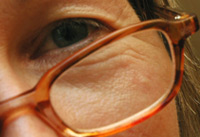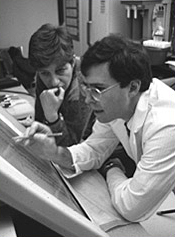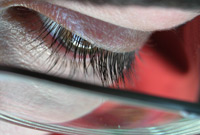Research
Introduction

Our research mission is to encourage and support department members in conducting collaborative, fully funded research in the visual sciences, and to use our clinical and research capabilities to quickly bring new knowledge to patient care settings. Our expertise in both clinical and basic research, as well as pharmaceutical clinical trials, puts us in a strong position to successfully achieve our mission.
The department supports clinical faculty members representing all subspecialty areas of ophthalmology, as well as research faculty. We are currently receiving over $3,000,000 from NIH and other sources for research projects.
Based on the current research interests of the faculty, our future plans are to develop strengths in three areas: macular degeneration (Steven Bernstein, MD, PhD; Robert Flower; Mary Johnson; PhD), cornea (Ramzi Hemady, MD, Shay-Whey Koh, PhD, Allan Rutzen, MD, Shambhu Varma, PhD) and glaucoma/neuroprotection (Nancy Ellish, DrPH, Howard Pomeranz, MD, PhD).
Basic Research
Lens biochemistry (Shambu Varma, PhD)
The primary focus of this lab is the study of ocular lens metabolism in relation to the pathogenesis of cataracts. This research involves the relationship of nutrition, carbohydrate metabolism, and oxidative stress to the biochemistry and physiology of cataract formation. P.S. Devamanoharan, Ph.D., a research associate in this lab, conducts research involving the anti-cataractogenic role of taurine, a sulfonated amino acid present in the lens.
Molecular biology (Steven Bernstein, MD, PhD)

The main focus of this lab is to study the genetic processes involved in the aging retina and the causes of age-related macular degeneration. By defining the genetic processes occurring during the normal aging of the retina, we can identify previously unsuspected pathways that may be involved in the processes that result in age-related macular degeneration (ARMD). We can also define candidate genes for ARMD linkage analysis and begin to dissect the role of these genes in regulating aging retinal function. By understanding the genetic interactions responsible for retinal aging and ARMD, we will be able to develop enhanced, effective treatment options for this disease.
This lab has been actively working on three projects: developing functional genomic correlates of retinal activity, characterizing age-related total retinal gene expression, and analyzing heat shock cognate 70 (HSC70) function in the retina. We will continue to identify and characterize human retinal gene expression. This work is now entering the 'microchip age', with the development of retinal and ocular 'gene chips' currently in development, in collaboration with NEI and the genetics department. We will also continue our analysis of HSC70 function in the retina to determine the role its decline has on retinal ability. This work has now entered the protein stage, with the development of a tissue culture model to directly determine the effect of HSC70 reduction on the neuronal stress response. Protein co-immunoprecipitation methods, immunohistological methods, and molecular techniques are being actively employed in this project.
Ocular cell biochemistry (Shay-Whey Koh, PhD)
"image right">
This lab is conducting research on neurotrophic factor modulation of corneal endothelium. Specifically, we are studying how ciliary neurotrophic factor (CNTF), a putative autocrine trophic factor of the corneal endothelium, and an injury factor containing no signal sequence for secretion, is released from the corneal endothelium. We are also continuing research with vasoactive intestinal peptide (VIP) to demonstrate the human corneal endothelium survival-promoting activities of VIP in corneas subjected to oxidative stress.
Ocular hemodynamics (Robert Flower)
This research was designed to determine the frequency with which potentially treatable feeder vessels of juxta- and sub-foveal ARMD-associated choroidal neovascularization (CNV) can be detected, using multiple high-speed pulsed-laser ICG angiography. In collaboration with faculty members of the UMBC Mechanical Engineering Department, we are developing a working model of the relationship between the retinal and choroidal circulations and interstitial fluid dynamics. This model has the potential to be used in determining strategic placement of laser photocoagulation burns that will achieve a particular perturbation in choroidal blood flow distribution, and thereby remedy some localized fluid dynamic anomalies.
